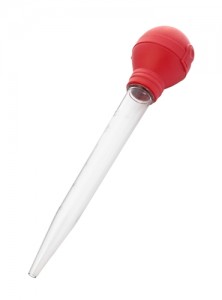Can’t conceive? Try IVF. Sure, it recently earned a Nobel Prize but isn’t that like going from 0 to 100 mph just like that? Isn’t there something simpler to do first before IVF?
Turkey Basting
Well, maybe there is. There are 3 levels of conception technology: No-Tech (sex), Low-Tech (IUI) and High-Tech (IVF). Intrauterine insemination (IUI) is the classic low-tech approach to pregnancy. It involves the placement of a washed sample of ejaculated sperm into the female uterus, well beyond the vagina and cervix where ejaculated sperm normally find themselves after sex. It is performed during ovulation to maximize the chance that sperm meets egg. And, like sex (and unlike IVF-ICSI) it adheres to the Darwinian principle: “may the best sperm win.”

Medical lore has it that the first case of human artificial insemination occurred in Philadelphia in 1884. Apparently, a medical professor took sperm from his “best looking” student and inseminated a woman who had an infertile husband. Human artificial insemination with the male partner’s sperm began in earnest in the 1940’s, well after the first animal husbandry case in 1784.
The Old IUI
Historically, IUI has been performed in women with unexplained infertility or coital disorders, those with cervical “issues,” and those who use donor sperm. IUI is also used in cases of low partner semen quality and for men with problems with erections or ejaculation, for example men with spinal cord injury. Over the last 75 years and millions of cases, several truths have surfaced with artificial insemination:
- Pregnancy success varies widely but is generally related to female fertility potential.
- If enough sperm are inseminated, typically 5 to 10 million moving sperm, then optimal pregnancy rates are obtained.
- When done with medications, termed “stimulated IUI” achievable pregnancy rates closely mimic natural rates for women who are not otherwise infertile.
So, IUI has been a workhorse technique for years in our field…until IVF came around in the late 1970s. Perusing a popular research database (PubMed) of published papers, you’ll find 10-fold more papers pertaining to IVF (16,000+) compared to IUI (+1700) So, where is IVF’s older sister today?
The New IUI
OK, I’ll admit it: I really like IUI for male factor infertility. I think its because if you can hit certain thresholds of sperm numbers, then pregnancy rates reflect the female partner’s fertility. This means that IUI can remove many male factor issues from the fertility equation. That’s it, all done. Given this, exactly where does IUI fit into my practice?
- When pregnancies are not achieved at home after vasectomy reversal despite reasonable semen quality. Most couples chose reversal rather than sperm retrieval and IVF-ICSI for a good reason and IUI fits in nicely with this family-building philosophy.
- With male factor infertility due to varicocele. Although natural pregnancies are the Holy Grail after varicocele repair, we reported that many couples with IVF-caliber semen quality could avoid IVF and simply use IUI after varicocele repair. IUI has played a major role in this “shift of care” strategy away from high tech toward low-tech pregnancies.
- When medical therapy has improved but has not normalized semen quality and pregnancies are simply not happening at home. IUIs can work with ¼ of the semen quality typically needed for natural conception.
In guy talk, IUI has allowed men to not only pack more bullets in the gun, but also allows them to fire bullets farther than they would normally go. Who doesn’t need a little boost now and then?
Cross-posted from turekonmenshealth.com



